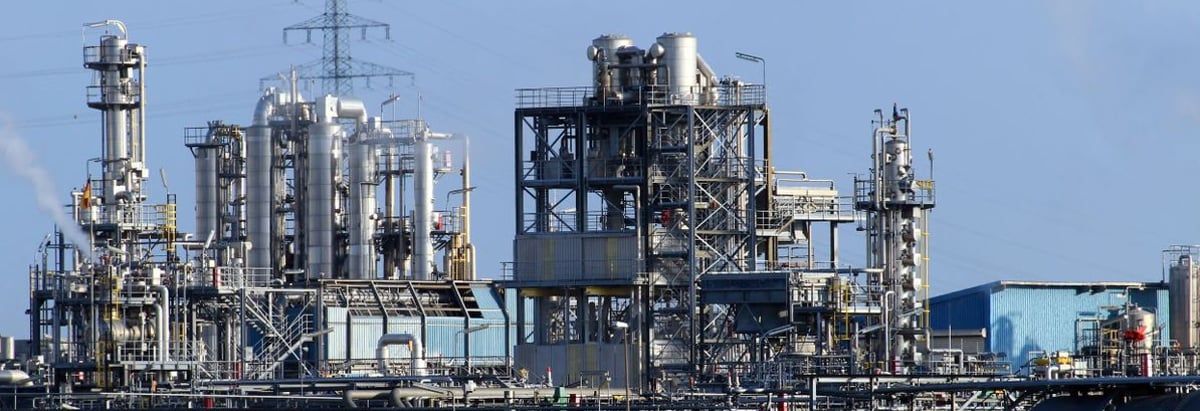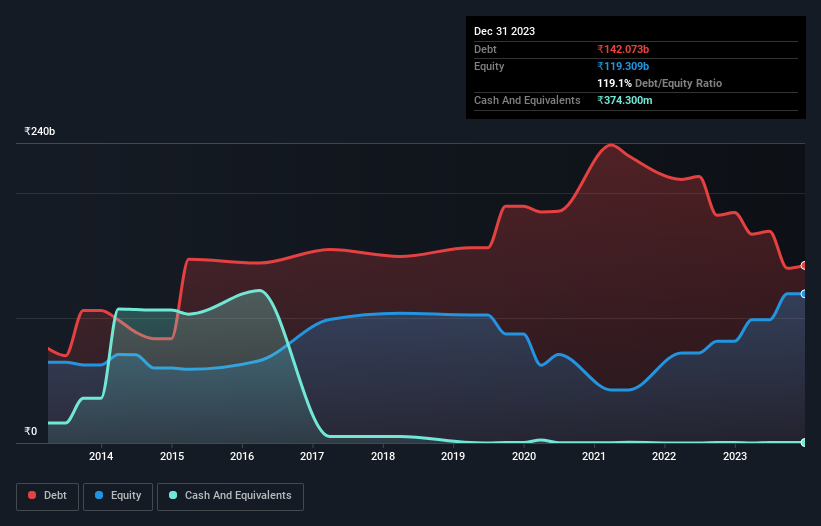
Howard Marks put it nicely when he said that, rather than worrying about share price volatility, 'The possibility of permanent loss is the risk I worry about... and every practical investor I know worries about.' So it might be obvious that you need to consider debt, when you think about how risky any given stock is, because too much debt can sink a company. As with many other companies Mangalore Refinery and Petrochemicals Limited (NSE:MRPL) makes use of debt. But the real question is whether this debt is making the company risky.
When Is Debt A Problem?
Debt is a tool to help businesses grow, but if a business is incapable of paying off its lenders, then it exists at their mercy. In the worst case scenario, a company can go bankrupt if it cannot pay its creditors. However, a more frequent (but still costly) occurrence is where a company must issue shares at bargain-basement prices, permanently diluting shareholders, just to shore up its balance sheet. Of course, debt can be an important tool in businesses, particularly capital heavy businesses. When we think about a company's use of debt, we first look at cash and debt together.
View our latest analysis for Mangalore Refinery and Petrochemicals
What Is Mangalore Refinery and Petrochemicals's Net Debt?
You can click the graphic below for the historical numbers, but it shows that Mangalore Refinery and Petrochemicals had ₹142.1b of debt in September 2023, down from ₹184.4b, one year before. And it doesn't have much cash, so its net debt is about the same.

A Look At Mangalore Refinery and Petrochemicals' Liabilities
We can see from the most recent balance sheet that Mangalore Refinery and Petrochemicals had liabilities of ₹121.0b falling due within a year, and liabilities of ₹115.7b due beyond that. On the other hand, it had cash of ₹374.3m and ₹40.0b worth of receivables due within a year. So its liabilities total ₹196.2b more than the combination of its cash and short-term receivables.
While this might seem like a lot, it is not so bad since Mangalore Refinery and Petrochemicals has a market capitalization of ₹355.1b, and so it could probably strengthen its balance sheet by raising capital if it needed to. However, it is still worthwhile taking a close look at its ability to pay off debt.
In order to size up a company's debt relative to its earnings, we calculate its net debt divided by its earnings before interest, tax, depreciation, and amortization (EBITDA) and its earnings before interest and tax (EBIT) divided by its interest expense (its interest cover). This way, we consider both the absolute quantum of the debt, as well as the interest rates paid on it.
Mangalore Refinery and Petrochemicals has net debt of just 1.4 times EBITDA, indicating that it is certainly not a reckless borrower. And it boasts interest cover of 7.7 times, which is more than adequate. In addition to that, we're happy to report that Mangalore Refinery and Petrochemicals has boosted its EBIT by 76%, thus reducing the spectre of future debt repayments. There's no doubt that we learn most about debt from the balance sheet. But it is future earnings, more than anything, that will determine Mangalore Refinery and Petrochemicals's ability to maintain a healthy balance sheet going forward. So if you want to see what the professionals think, you might find this free report on analyst profit forecasts to be interesting.
Finally, a company can only pay off debt with cold hard cash, not accounting profits. So we always check how much of that EBIT is translated into free cash flow. Over the last three years, Mangalore Refinery and Petrochemicals recorded free cash flow worth a fulsome 88% of its EBIT, which is stronger than we'd usually expect. That positions it well to pay down debt if desirable to do so.
Our View
Happily, Mangalore Refinery and Petrochemicals's impressive conversion of EBIT to free cash flow implies it has the upper hand on its debt. But truth be told we feel its level of total liabilities does undermine this impression a bit. When we consider the range of factors above, it looks like Mangalore Refinery and Petrochemicals is pretty sensible with its use of debt. While that brings some risk, it can also enhance returns for shareholders. The balance sheet is clearly the area to focus on when you are analysing debt. But ultimately, every company can contain risks that exist outside of the balance sheet. Be aware that Mangalore Refinery and Petrochemicals is showing 3 warning signs in our investment analysis , and 1 of those shouldn't be ignored...
At the end of the day, it's often better to focus on companies that are free from net debt. You can access our special list of such companies (all with a track record of profit growth). It's free.
New: Manage All Your Stock Portfolios in One Place
We've created the ultimate portfolio companion for stock investors, and it's free.
• Connect an unlimited number of Portfolios and see your total in one currency
• Be alerted to new Warning Signs or Risks via email or mobile
• Track the Fair Value of your stocks
Have feedback on this article? Concerned about the content? Get in touch with us directly. Alternatively, email editorial-team (at) simplywallst.com.
This article by Simply Wall St is general in nature. We provide commentary based on historical data and analyst forecasts only using an unbiased methodology and our articles are not intended to be financial advice. It does not constitute a recommendation to buy or sell any stock, and does not take account of your objectives, or your financial situation. We aim to bring you long-term focused analysis driven by fundamental data. Note that our analysis may not factor in the latest price-sensitive company announcements or qualitative material. Simply Wall St has no position in any stocks mentioned.
About NSEI:MRPL
Mangalore Refinery and Petrochemicals
Engages in the manufacture and sale of refined petroleum products in India and internationally.
Average dividend payer and fair value.
Similar Companies
Market Insights
Community Narratives



